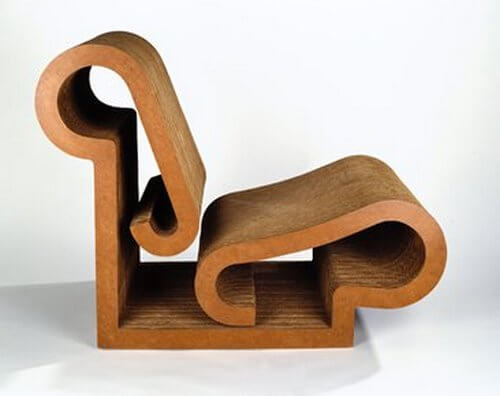The Wiggle Side Chair is part of Frank Gehry’s 1972 furniture series ‘Easy Edges’, which brought new aesthetic dimension to an everyday material: cardboard. The sculptural chair is comfortable, yet also rather robust.
Cardboard Furniture
Frank Gehry was one of the first designers to produce cardboard furniture when he created the Wiggle side chair in 1972. Since the 1960s, manufacturers had sought an alternative to plastic, but they struggled to find anything that could compete with its lightweight flexibility.

Image source: https://search.creativecommons.org/photos/46cbf628-8d11-4b5b-9d10-73f753d52750 by sheilaellen
At the time, failed attempts to reinforce single layer cardboard were done by inserting tabs and slots. But Gehry, who was born in 1929, came up with a solution thanks in part to childhood spent playing in his grandfather’s hardware store building villages and cities from scraps of plywood. One day, the architect saw a pile of corrugated cardboard outside his office and began to experiment. He was already using cardboard to build architecture models and realised that it became very strong when glued together. To increase the strength and resilience of the material, layers of cardboard were laminated at right angles to one another.

Image source: https://search.creativecommons.org/photos/2ad225ec-19b4-49c5-8621-dfb5a59ca9f1 by puffin11uk
Easy Edge
Easy Edges, the series of furniture designs by Frank Gehry from 1969 to 1973, are partially responsible for Gehry’s rise to fame in the early 1970s. After discovering that corrugated cardboard becomes suitable for the everyday use when layered enough times in alternate directions, Gehry created pieces such as the “Easy Edges Wiggle Side Chair” that take advantage of cardboard’s versatility. Hardboard facing is applied to the cardboard furniture’s flat surfaces to further add durability to the designs.

Image source: https://hivemodern.com/pages/product243/wiggle-side-chair-frank-gehry-vitra
Gehry’s use of cardboard as a medium demonstrates his “fundamental concern with manipulating basic materials in unconventional ways to produce objects that are functional yet also visually striking”.

Image source: https://insteading.com/blog/cardboard-furniture/
Although the chair and table were largely successful, Gehry was unhappy because his high-priced pieces conflicted with his philosophy that furniture should be affordable to all. Consequently, Gehry abandoned furniture design and returned to architecture.
Despite their simple appears, the “Easy Edges” pieces are nonetheless constructed with an architect’s care and are robust and sturdy.

Image source: https://search.creativecommons.org/photos/13787f3a-d938-4641-9de6-034751762024 by ivanx
Frank Ghery
Frank Gehry, born 1929 in Toronto, Canada, earned a degree in architecture from the University of Southern California before studying urban planning at Harvard University’s Graduate School of Design.

Image source: https://en.wikipedia.org/wiki/Frank_Gehry#/media/File:Frank_O._Gehry_-_Parc_des_Ateliers_(cropped).jpg
In 1962, he founded the Los Angeles architectural firm Frank Gehry & Associates, where he designed the Easy Edges series between 1969-72. Since then, he has taught at several universities, including Harvard and Yale, where he served as the Charlotte-Davenport-Professorship of Architecture (1982, 1985, 1987-89) and where he teaches today. Gehry has received numerous honorary doctorates from institutions including the University of Toronto, the University of Southern California, Yale University, Harvard University and the University of Edinburgh.
Data Sheet
Designer: Frank Gehry
Year: 1972
Manufacturer: Vitra.
Dimension: 33 x 14 1/2 x 23 in. (83.82 x 36.83 x 58.42 cm)
Medium: Laminated corrugated cardboard

Image source: https://search.creativecommons.org/photos/af8ed8c3-2d3d-4e85-a39a-49fa34071cbf by Frank Gehry
Info source: https://www.ft.com/content/65ebb456-97cc-11e3-ab60-00144feab7de
Info source: https://www.danishdesignstore.com/products/frank-gehry-wiggle-side-chair-vitra
Info source: https://en.wikipedia.org/wiki/Easy_Edges
Info source: https://www.vitra.com/en-it/corporation/designer/details/frank-gehry
Info source: https://collections.artsmia.org/art/4393/wiggle-side-chair-from-the-easy-edges-series-frank-gehry#
